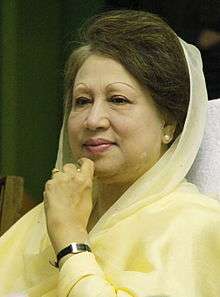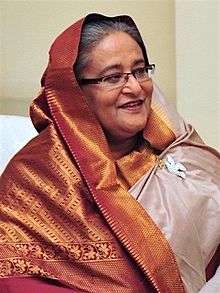1996 in Bangladesh
1996 (MCMXCVI) was a leap year starting on Monday of the Gregorian calendar, the 1996th year of the Common Era (CE) and Anno Domini (AD) designations, the 996th year of the 2nd millennium, the 96th year of the 20th century, and the 7th year of the 1990s decade.
| |||||
| Centuries: |
| ||||
|---|---|---|---|---|---|
| Decades: |
| ||||
| See also: | Other events of 1996 List of years in Bangladesh | ||||
The year 1996 was the 25th year after the independence of Bangladesh. It was also the first year of the first term of the Government of Sheikh Hasina.
Incumbents

Khaleda
Zia
Zia

Habibur
Rahman
Rahman

Sheikh
Hasina
Hasina
- President: Abdur Rahman Biswas (until 9 October), Shahabuddin Ahmed (starting 9 October)
- Prime Minister:
- until 30 March: Khaleda Zia
- 30 March – 23 June: Muhammad Habibur Rahman
- starting 23 June: Sheikh Hasina
- Chief Justice: A.T.M Afzal
Demography
| Population, total | 121,269,645 |
| Population density (per km2) | 931.6 |
| Population growth (annual %) | 2.1% |
| Male to Female Ratio (every 100 Female) | 104.3 |
| Urban population (% of total) | 22.1% |
| Birth rate, crude (per 1,000 people) | 30.3 |
| Death rate, crude (per 1,000 people) | 8 |
| Mortality rate, under 5 (per 1,000 live births) | 108.3 |
| Life expectancy at birth, total (years) | 62.6 |
| Fertility rate, total (births per woman) | 3.6 |
Climate
| Climate data for Bangladesh in 1996 | |||||||||||||
|---|---|---|---|---|---|---|---|---|---|---|---|---|---|
| Month | Jan | Feb | Mar | Apr | May | Jun | Jul | Aug | Sep | Oct | Nov | Dec | Year |
| Daily mean °C (°F) | 18.9 (66.0) |
20.4 (68.7) |
26.3 (79.3) |
27.8 (82.0) |
28.6 (83.5) |
28.1 (82.6) |
28.2 (82.8) |
27.8 (82.0) |
28.1 (82.6) |
26.5 (79.7) |
23.5 (74.3) |
19.2 (66.6) |
25.3 (77.5) |
| Average precipitation mm (inches) | 6.1 (0.24) |
33.7 (1.33) |
49.7 (1.96) |
202.2 (7.96) |
232.1 (9.14) |
405.1 (15.95) |
418.3 (16.47) |
406.9 (16.02) |
278.4 (10.96) |
245.4 (9.66) |
4.4 (0.17) |
0.2 (0.01) |
2,282.5 (89.87) |
| Source: Climatic Research Unit (CRU) of University of East Anglia (UEA)[2] | |||||||||||||
Economy
| National Income | |||
|---|---|---|---|
| Current US$ | Current BDT | % of GDP | |
| GDP | $46.4 billion | BDT1,899.3 billion | |
| GDP growth (annual %) | 4.5% | ||
| GDP per capita | $382.9 | BDT15,662 | |
| Agriculture, value added | $10.8 billion | BDT441.9 billion | 24.5% |
| Industry, value added | $10.1 billion | BDT411.9 billion | 22.8% |
| Services, etc., value added | $23.3 billion | BDT952.0 billion | 52.7% |
| Balance of Payment | |||
| Current US$ | Current BDT | % of GDP | |
| Current account balance | -$991.4 million | -2.1% | |
| Imports of goods and services | $7,450.6 million | BDT310.9 billion | 16.4% |
| Exports of goods and services | $4,614.1 million | BDT184.4 billion | 9.7% |
| Foreign direct investment, net inflows | $13.5 million | 0.0% | |
| Personal remittances, received | $1,344.7 million | 2.9% | |
| Total reserves (includes gold) at year end | $1,869.5 million | ||
| Total reserves in months of imports | 2.9 | ||
Note: For the year 1996 average official exchange rate for BDT was 41.79 per US$.
Events
- 9 January - At least 16 people were killed and more than 100 injured in the head-on collision of two trains near Chandpur.[3]
- 15 February - The Sixth National Parliamentary Elections 1996 was held in Bangladesh on 15 February 1996. They were boycotted by most opposition parties, and saw voter turnout drop to just 21%.[4] The result was a victory for the Bangladesh Nationalist Party (BNP), which won 300 of the 300 elected seats.[4]
- 22 March – Inauguration of Liberation War Museum.
- 25 March – Following escalating political turmoil, the sitting Parliament enacted the thirteenth constitutional amendment to allow a neutral caretaker government to assume power and conduct new parliamentary elections. On 30 March the President appointed former Chief Justice Muhammad Habibur Rahman as Chief Advisor (a position equivalent to prime minister) in the interim government. A new election was scheduled for 12 June 1996.
- 14 May – Over 400 are killed as a tornado strikes northern Bangladesh.[5]
- 19 May – Failed attempt of coup d'état by Lt. Gen. Abu Saleh Mohammad Nasim, Bir Bikram.
- 12 June – The Seventh National Parliamentary Elections 1996 were held in Bangladesh on 12 June 1996. The result was a victory for the Bangladesh Awami League, which won 146 of the 300 seats, beginning Sheikh Hasina's first-term as Prime Minister. Voter turnout was 75.6%, the highest to date.[4] This election was the second to be held in 1996, following controversial elections held in February a few months earlier.
- 5 November – Starting with a base of 350 points, the share price index of the Dhaka Stock Exchange rose as high as 3,648.75 points. The following day it started falling and it came down to 462 points in May 1999. The crash left millions of investors penniless.[6]
- 12 December – A 30-year treaty on sharing of the Ganges water was signed between India and Bangladesh.[7]
Sports
- Olympics:
- Bangladesh sent a delegation to compete in the 1996 Summer Olympics in Atlanta, United States. Bangladesh did not win any medals in the competition.
- Domestic football:
- Mohammedan SC won Dhaka League title while Abahani KC came out runner-up.[8]
Births
- 15 April – Faraaz Ayaaz Hossain, martyr (d. 2016)
Deaths
Epitaph of Shah's grave located in Sylhet.
- 10 January – Alamgir M. A. Kabir, social activist (b. 1911)
- 20 February – Kazi Abul Monsur, physician and microbiologist (b. 1918)
- 5 March – Khondaker Mostaq Ahmad, President of Bangladesh (b. 1919)[9]
- 9 April – Fazlul Halim Chowdhury, academician (b. 1930)
- 14 May – Abdul Ahad, music director (b. 1918)
- 6 September – Mohammad Noman, academician
- 6 September – Salman Shah, movie and TV actor (b. 1971)
gollark: They are of course "scoped #DEFINE pragmas".
gollark: But most of the live"CD" USB images will use some compressed rootfs thing so your changes are not persisted.
gollark: I have an arch install on a disk which is set up that way.
gollark: Go change your momentum.
gollark: Nature is *particularly* <:bees:724389994663247974>; it *created* <:bees:724389994663247974>.
References
- "World Development Indicators". The World Bank. Retrieved 27 May 2018.
- "Climate Change Knowledge Portal". The World Bank Group. Retrieved 27 May 2018.
- "Bangladesh train crash". UPI. Dhaka. 9 January 1996. Retrieved 21 July 2019.
- Dieter Nohlen; Florian Grotz; Christof Hartmann (2001). Elections in Asia: A data handbook. Volume I. p. 525. ISBN 0-19-924958-X.
- "Tornado kills more than 400 in Bangladesh". CNN. Archived from the original on 16 January 2007.
- "Tribunal moves on 1996 stock scam". The Daily Star. 6 August 2015. Retrieved 11 July 2019.
- Haq, Enamul (2012). "Ganges Water Sharing". In Islam, Sirajul; Jamal, Ahmed A. (eds.). Banglapedia: National Encyclopedia of Bangladesh (Second ed.). Asiatic Society of Bangladesh.
- "List of Champions". Atsushi Fujioka for Rec.Sport.Soccer Statistics Foundation. Retrieved 16 October 2018.
- Khan, Saleh Athar (2012). "Ahmad, Khondakar Mostaq". In Islam, Sirajul; Jamal, Ahmed A. (eds.). Banglapedia: National Encyclopedia of Bangladesh (Second ed.). Asiatic Society of Bangladesh.
This article is issued from Wikipedia. The text is licensed under Creative Commons - Attribution - Sharealike. Additional terms may apply for the media files.